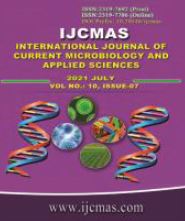


 National Academy of Agricultural Sciences (NAAS)
National Academy of Agricultural Sciences (NAAS)

|
PRINT ISSN : 2319-7692
Online ISSN : 2319-7706 Issues : 12 per year Publisher : Excellent Publishers Email : editorijcmas@gmail.com / submit@ijcmas.com Editor-in-chief: Dr.M.Prakash Index Copernicus ICV 2018: 95.39 NAAS RATING 2020: 5.38 |
The nature of child poverty is distinctively different from adult poverty in comprehension, measurement, and implications. In order to measure different facets of child poverty, 16 relevant child poverty factors were chosen and grouped into three poverty dimensions—deprivation, exclusion, and vulnerability. Then a multidimensional poverty study was employed with 300 randomly selected children in Palamu and Garwaha districts of Jharkhand, India to comprehensively estimate child poverty and its major contributing factors. This study also sought to understand if household income is correlated with the degree of poverty experienced by children. The study further experimented if child poverty was associated with gender. The study highlighted that the mean multidimensional poverty is estimated to be 0.48 and it ranges from 0.13 to 0.69. With a poverty cut-off of 0.4, 75% of children fall into the poverty bracket. If the cut-off is lowered to 0.3, 98% of children become poor. Sanitation (12.42%), inadequate shelter (10.7%), political conflict (10.4%), inaccessibility to water (10.1%), and discrimination on the basis of poor economic status (9%) are the major contributors to overall child poverty. When analyzed poverty dimension-wise, deprivation contributes 52.98% followed by exclusion (24.33%) and vulnerability (22.69%). Gender segregated poverty level was 0.4775 and 0.488 for boys and girls respectively and this was found statistically not different and it shows child poverty in the study areas strike male and female children equally. The correlation of child poverty and household income was reported to be poor, indicating that child poverty factors are not sufficiently minimized by the income of the parents.
 |
 |
 |
 |
 |